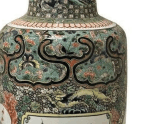Heidi Bjørgan

For Norwegian artist Heidi Bjørgan there are no bad experiences in the kiln. ‘If it’s broken in two, maybe I can re-use part of it,’ she says. ‘I can re-glaze it, put raw clay on it, re-fire it’. Casting objects from her collection of readymades, using components ‘left over’ after casting, incorporating found objects or items selected through collaboration, applying ‘crazy’ glazes and re-firing again and again, her works sometimes look as if they have melted or imploded in the kiln. Challenging our perception of what ceramic art should be, they are spontaneous and uninhibited. Choosing not to keep a meticulous record of glazes and temperatures, each piece brings something new and unexpected, even to Bjørgan herself. Aiming to do something different every time, to extend her aesthetic vocabulary and achieve the impossible, her objects appear indeterminable, yet strangely familiar; peculiar, yet totally engaging.
Heidi Bjørgan continues this tradition of rule breakers and, just
You’re reading a preview, subscribe to read more.
Start your free 30 days



